Adaptive Liquid Lens Actuated by Droplet Movement
Abstract
:1. Introduction
2. Device Mechanism and Fabrication

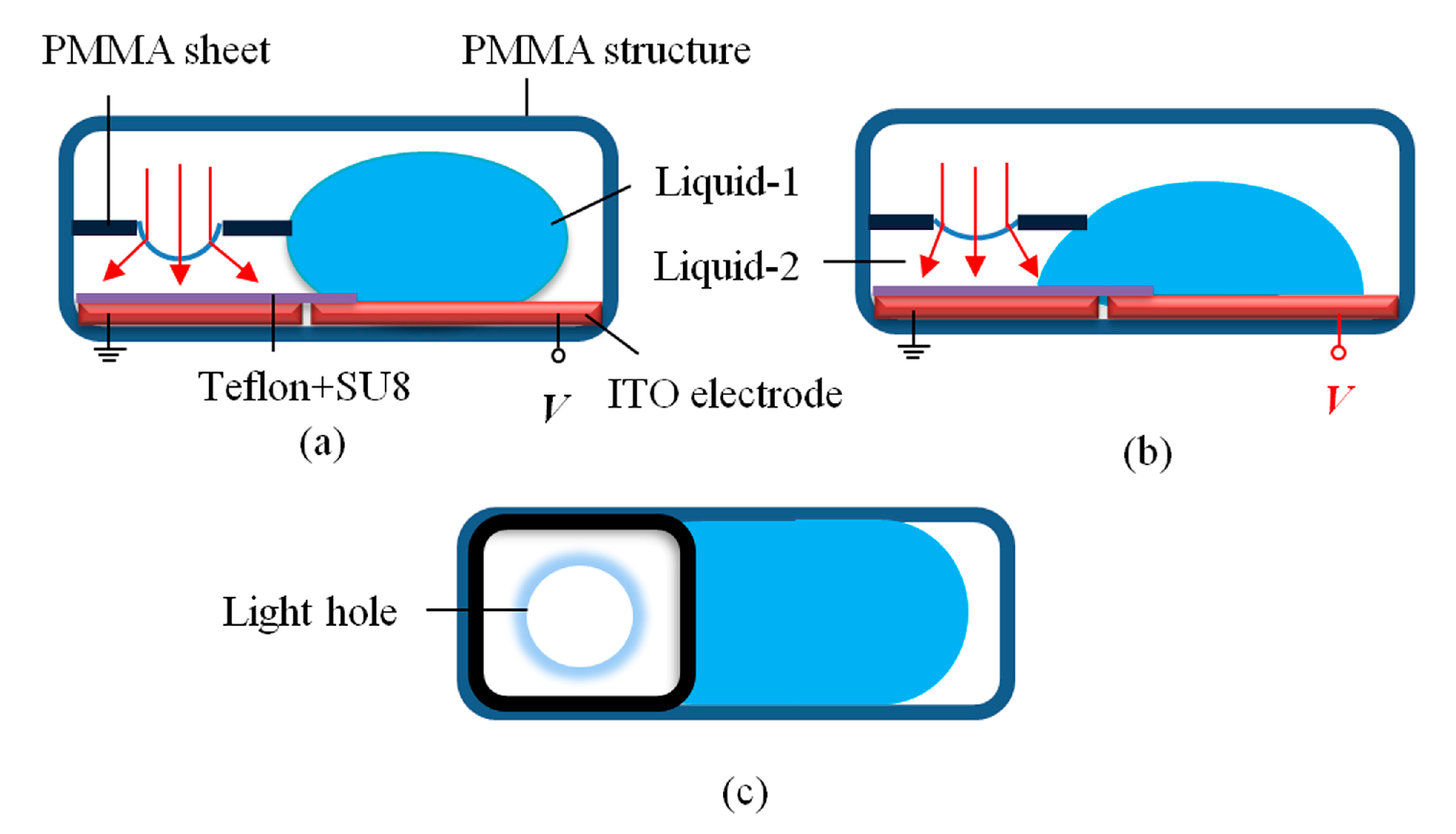
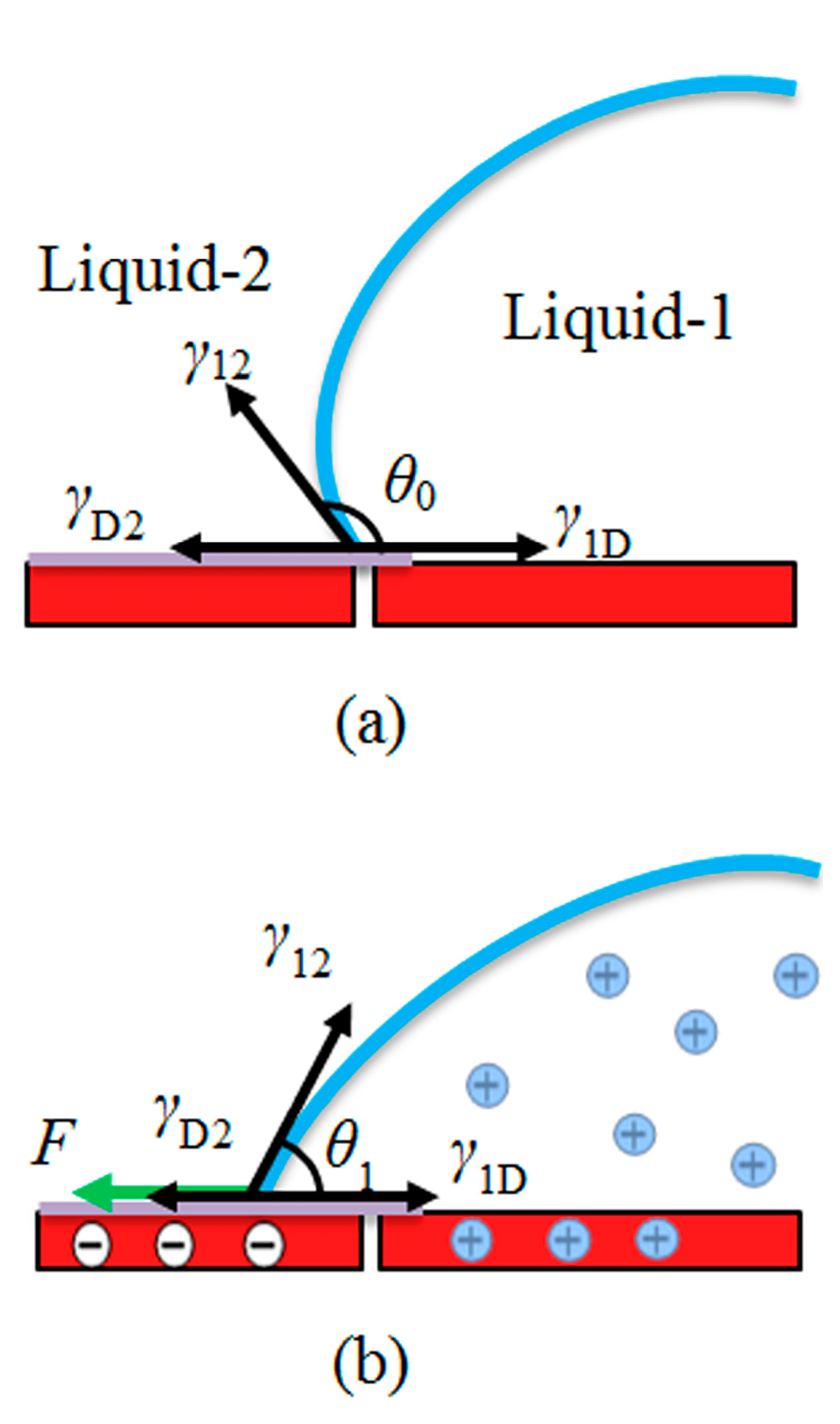
3. Experiment and Discussion
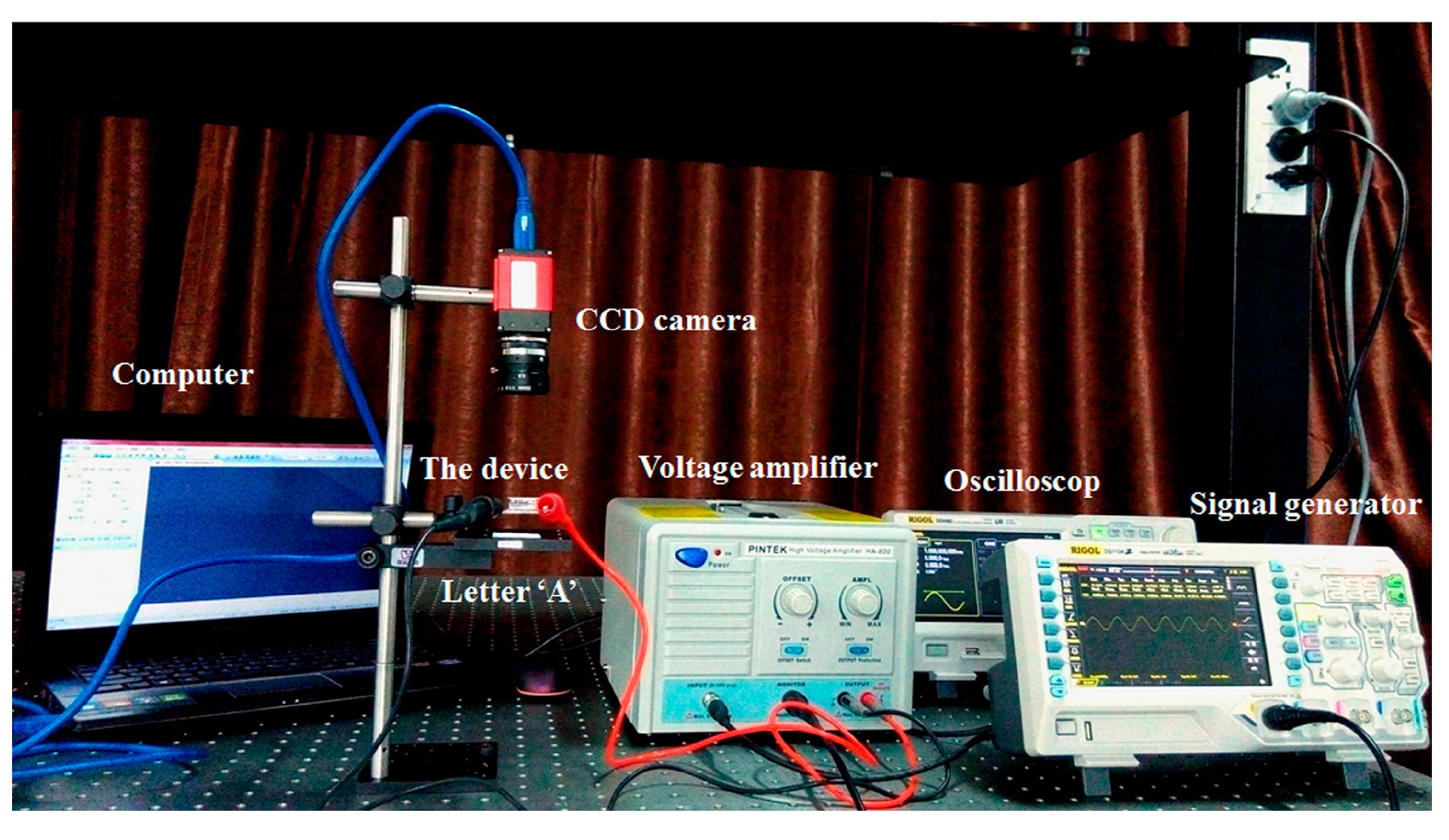

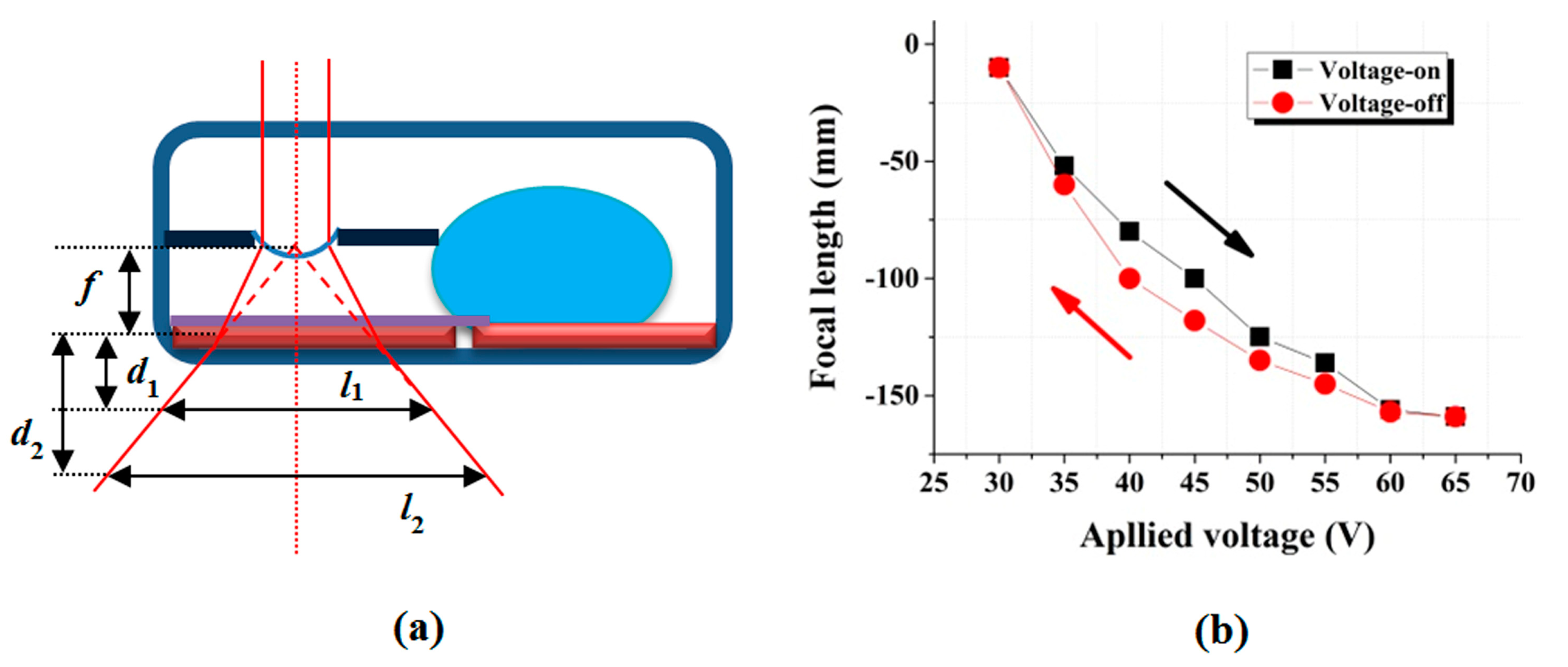
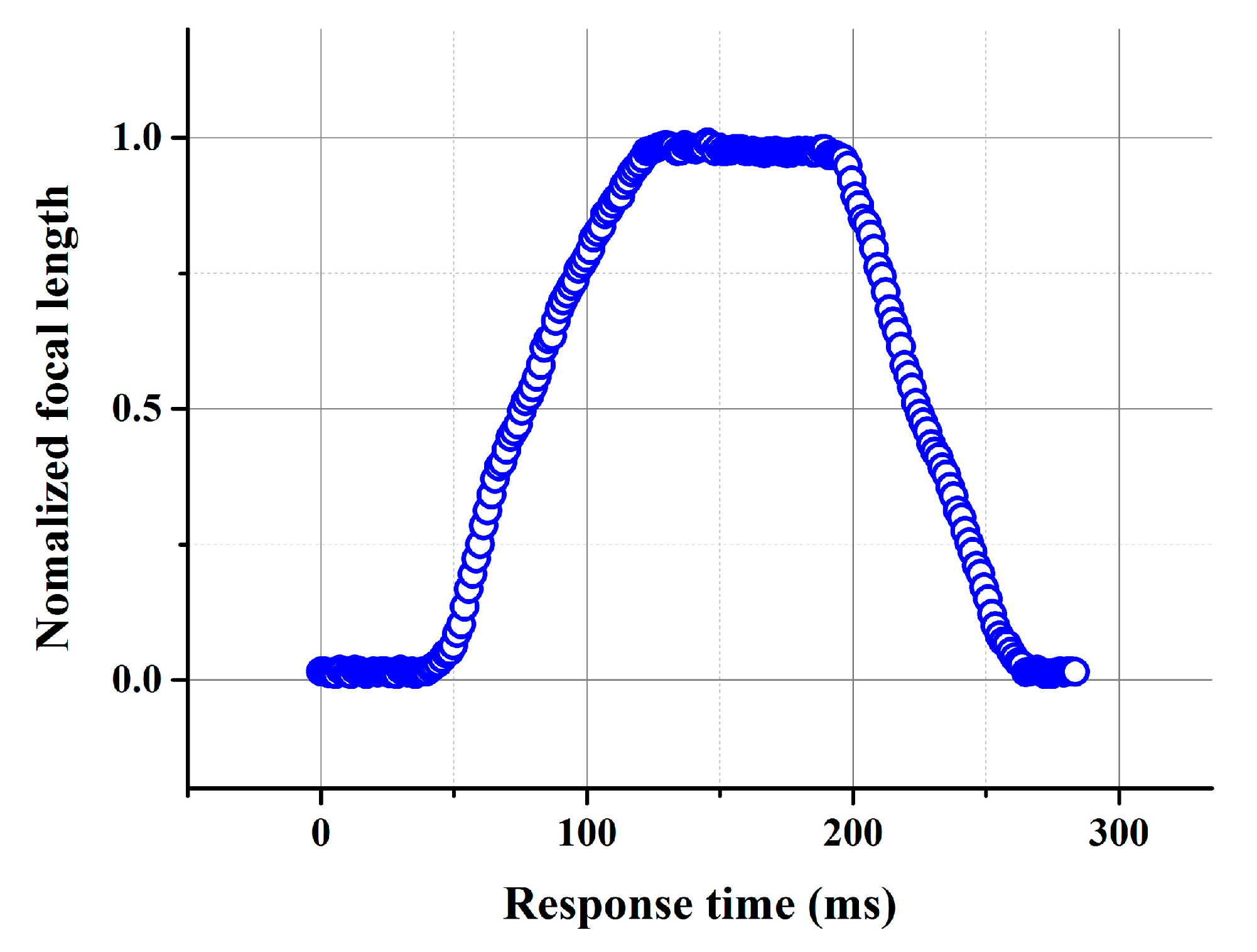
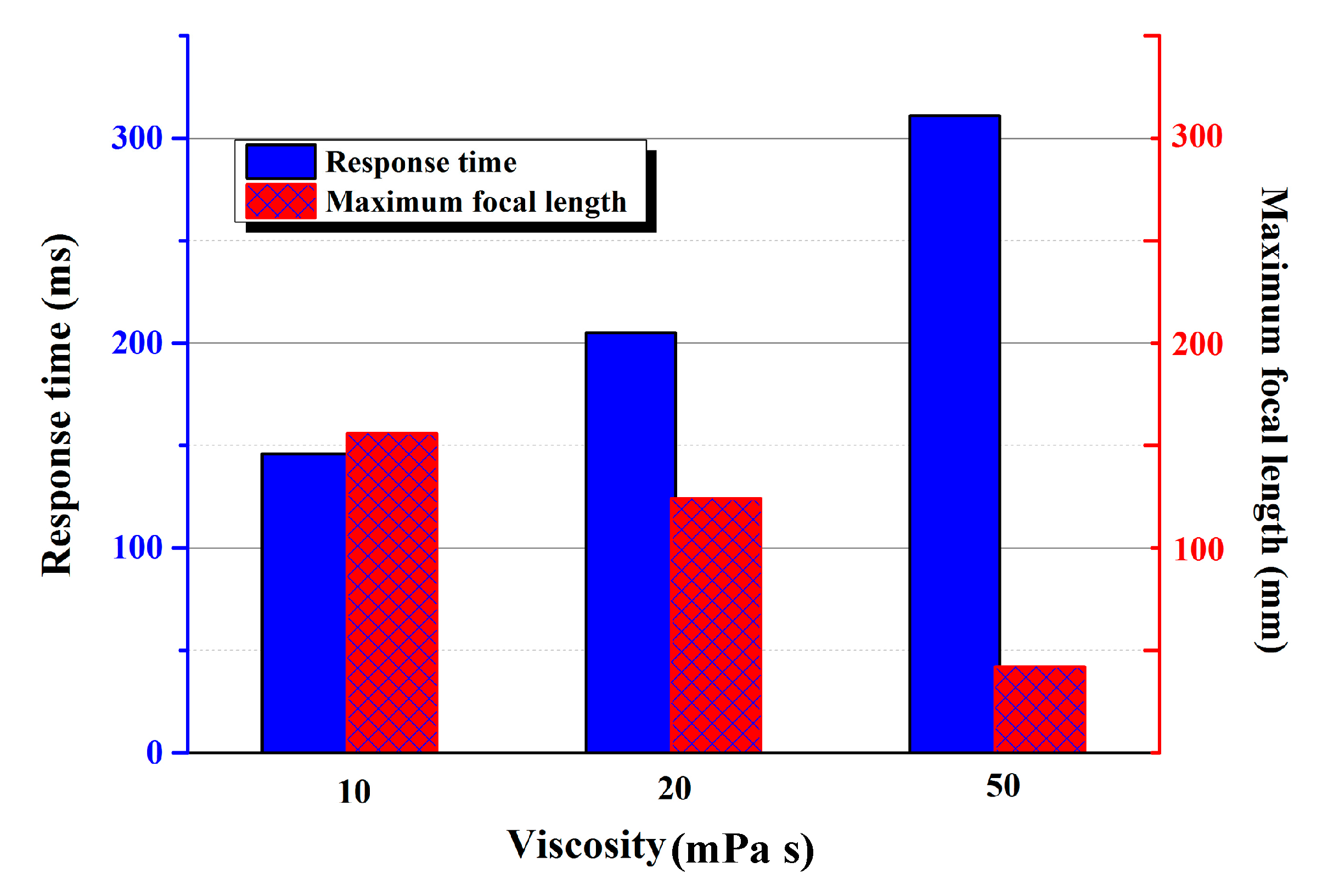
4. Conclusions
Acknowledgments
Author Contributions
Conflicts of Interest
References
- Xu, M.; Zhou, Z.W.; Ren, H.; Lee, S.H.; Wang, Q.H. Tunable liquid microlens. J. Appl. Phys. 2013, 113. [Google Scholar] [CrossRef]
- Wang, B.; Ye, M.; Sato, S. Liquid crystal lens with focal length variable from negative to positive values. IEEE Photonics Technol. Lett. 2006, 18, 79–81. [Google Scholar] [CrossRef]
- Hwang, S.J.; Liu, Y.X.; Porter, G.A. Tunable liquid crystal microlenses with crater polymer prepared by droplet evaporation. Opt. Express 2013, 21, 30731–30738. [Google Scholar] [CrossRef]
- Ren, H.; Xu, S.; Wu, S.T. Polymer-stabilized liquid crystal microlens array with large dynamic range and fast response time. Opt. Lett. 2013, 38, 3144–3147. [Google Scholar] [CrossRef]
- Ye, M.; Wang, B.; Sato, S. Liquid-crystal lens with a focal length that is variable in a wide range. Appl. Opt. 2004, 43, 6407–6412. [Google Scholar] [CrossRef]
- Bergea, B.; Peseux, J. Variable focal lens controlled by an external voltage: An application of electrowetting. Eur. Phys. J. E. 2000, 3, 159–163. [Google Scholar] [CrossRef]
- Peng, R.; Wang, D.Z.; Hu, Z.W.; Chen, J.B.; Zhuang, S.L. Focal length hysteresis of a double-liquid lens based on electrowetting. J. Opt. 2013, 15. [Google Scholar] [CrossRef]
- Kuipera, S.; Hendriks, B.H.W. Variable-focus liquid lens for miniature cameras. Appl. Phys. Lett. 2004, 99. [Google Scholar] [CrossRef]
- Krupenkin, T.; Yang, S.; Mach, P. Tunable liquid microlens. Appl. Phys. Lett. 2003, 82, 316–318. [Google Scholar] [CrossRef]
- Grilli, S.; Miccio, L.; Vespini, V.; Finizio, A.; Nicola, S.D.; Ferraro, P. Liquid micro-lens array activated by selective electrowetting on lithium niobate substrates. Opt. Express 2008, 16, 8084–8093. [Google Scholar] [CrossRef]
- Murade, C.U.; Ende, D.V.D.; Mugele, F. High speed adaptive liquid microlens array. Opt. Express 2012, 20, 18180–18187. [Google Scholar] [CrossRef]
- Choi, H.; Won, Y. Fluidic lens of floating oil using round-pot chamber based on electrowetting. Opt. Lett. 2013, 38, 2197–2199. [Google Scholar] [CrossRef]
- Li, C.H.; Jiang, H.R. Electrowetting-driven variable-focus microlens on flexible surfaces. Appl. Phys. Lett. 2012, 100. [Google Scholar] [CrossRef]
- Liu, C.X.; Park, J.; Choi, J.W. A planar lens based on the electrowetting of two immiscible liquids. J. Micromech. Microeng. 2008, 18. [Google Scholar] [CrossRef]
- Cheng, C.C.; Yeh, J.A. Dielectrically actuated liquid lens. Opt. Express 2007, 15, 7140–7145. [Google Scholar] [CrossRef]
- Ren, H.; Xianyu, H.; Xu, S.; Wu, S.T. Adaptive dielectric liquid lens. Opt. Express 2008, 16, 14954–14960. [Google Scholar]
- Tsai, C.G.; Chen, C.N.; Cheng, L.S.; Cheng, C.C.; Yang, J.T.; Yeh, J.A. Planar liquid confinement for optical centering of dielectric liquid lenses. IEEE Photonics Technol. Lett. 2009, 21, 1396–1398. [Google Scholar] [CrossRef]
- Yang, C.C.; Tsai, C.G.; Yeh, J.A. Dynamic behavior of liquid microlenses actuated using dielectric force. J. Microelectromech. Syst. 2011, 20, 1143–1149. [Google Scholar] [CrossRef]
- Li, L.; Wang, Q.H.; Jiang, W. Liquid lens with double tunable surfaces for large power tunability and improved optical performance. J. Opt. 2011, 13. [Google Scholar] [CrossRef]
- Xu, S.; Ren, H.; Wu, S.T. Adaptive liquid lens actuated by liquid crystal pistons. Opt. Express 2012, 20, 28518–28523. [Google Scholar] [CrossRef]
- Moran, P.M.; Dharmatilleke, S.; Khaw, A.H.; Tan, K.W.; Chan, M.L.; Rodrigueza, I. Fluidic lenses with variable focal length. Appl. Phys. Lett. 2006, 88. [Google Scholar] [CrossRef]
- Mao, X.; Stratton, Z.I.; Nawaz, A.A.; Lin, S.C.S.; Huang, T.J. Optofluidic tunable microlens by manipulating the liquid meniscus using a flared microfluidic structure. Biomicrofluidics 2010, 4. [Google Scholar] [CrossRef]
- Dong, L.; Agarwal, A.K.; Beebe, D.J.; Jiang, H. Adaptive liquid microlenses activated by stimuli-responsive hydrogels. Nature 2006, 442, 551–554. [Google Scholar] [CrossRef]
- Song, C.L.; Nguyen, N.T.; Asundi, A.K.; Low, C.L.N. Biconcave micro-optofluidic lens with low-refractive-index liquids. Opt. Lett. 2009, 34, 3622–3624. [Google Scholar] [CrossRef]
- Mugele, F.; Baret, J.C. Electrowetting: From basics to applications. J. Phys Condens. Matter. 2005, 17, R705–R774. [Google Scholar] [CrossRef]
© 2014 by the authors; licensee MDPI, Basel, Switzerland. This article is an open access article distributed under the terms and conditions of the Creative Commons Attribution license (http://creativecommons.org/licenses/by/3.0/).
Share and Cite
Liu, C.; Wang, Q.-H.; Yao, L.-X.; Wang, M.-H. Adaptive Liquid Lens Actuated by Droplet Movement. Micromachines 2014, 5, 496-504. https://doi.org/10.3390/mi5030496
Liu C, Wang Q-H, Yao L-X, Wang M-H. Adaptive Liquid Lens Actuated by Droplet Movement. Micromachines. 2014; 5(3):496-504. https://doi.org/10.3390/mi5030496
Chicago/Turabian StyleLiu, Chao, Qiong-Hua Wang, Li-Xiao Yao, and Ming-Huan Wang. 2014. "Adaptive Liquid Lens Actuated by Droplet Movement" Micromachines 5, no. 3: 496-504. https://doi.org/10.3390/mi5030496



